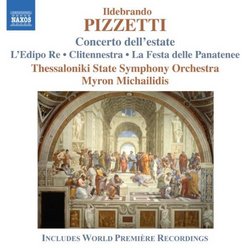| All Artists: Ildebrando Pizzetti, Myron Michailidis, Thessaloniki State Symphony Orchestra Title: Ildebrando Pizzetti: Concerto dell'estate; La Festa delle Panatenee Members Wishing: 1 Total Copies: 0 Label: Naxos Original Release Date: 1/1/2009 Re-Release Date: 4/28/2009 Genre: Classical Styles: Opera & Classical Vocal, Forms & Genres, Concertos, Theatrical, Incidental & Program Music, Symphonies Number of Discs: 1 SwapaCD Credits: 1 UPC: 747313201372 |
Search - Ildebrando Pizzetti, Myron Michailidis, Thessaloniki State Symphony Orchestra :: Ildebrando Pizzetti: Concerto dell'estate; La Festa delle Panatenee
 | Ildebrando Pizzetti, Myron Michailidis, Thessaloniki State Symphony Orchestra Ildebrando Pizzetti: Concerto dell'estate; La Festa delle Panatenee Genre: Classical |
Larger Image |
CD Details |
CD ReviewsAttractive Orchestral Music from Twentieth-Century Italy J Scott Morrison | Middlebury VT, USA | 05/26/2009 (5 out of 5 stars) "Ildebrando Pizzetti (1880-1968) was a member of the so-called 'Generation of 1880' that included fellow-composers Ottorino Respighi, Alfredo Casella and Gian Francesco Malipiero. This group wanted to sweep away what they considered to be the crudeness of the generation before them, the writers of verismo operas such as Puccini, Mascagni and Leoncavallo. They tended to focus primarily on instrumental music rather than opera, although Pizzetti did indeed write a number of operas, the most famous of which was his late (1958) 'Assassinio nella cattedrale' based on T.S. Eliot's verse drama 'Murder in the Cathedral', about the murder of Thomas à Becket. This disc contains his best-known orchestral work, 'Concerto dell'estate' (1928), as well as the Preludes from the incidental music for Sophocles' 'Oedipus Rex' (1903), and two pieces never recorded before: Prelude to his last opera 'Clitennestra' ('Clytemnestra') (1962-64) and 'La Festa della Panatenee'('The Feast of the Panathenaea') (1936), a suite of three pieces.
I've known the 'Concerto dell'estate' ('Summer Concerto') for more than forty years from a marvelous recording led by Lamberto Gardelli Pizzetti/Rota/Respighi. Pizzetti called it his 'pastoral symphony' and the three movements certainly evoke recollections of the Italian countryside. 'Mattutino' ('Morning') finds us in a setting with crowing roosters, awakening peasants full of optimism, and temporary fog or mist that clears to a scene of boisterous activity. Pizzetti's mastery of orchestration is in full evidence here. 'Notturno' ('Nocturne') is serene, impressionistic, evocative of the night. 'Gagliarda e Finale' ('Galliard and Finale') is musically neoclassical but almost Renaissance in feeling -- think Praetorius -- and one pictures peasants and nobility joining in joyful yet stately dance before the scene fades into the shadows. Three Preludes from 'Oedipus Rex': I is ominous, depicting the depredations of a plague in Thebes. II is impulsive and dramatic and has a lyrical middle section with a gorgeous oboe melody. III begins with a sad air but eventually full strings bring an emotional catharsis followed by a serene close. The five-minute-long Prelude to 'Clitennestra' presages the dark tale to come in the opera: Clytemnestra, wife of the Athenian King Agamemnon, has never forgiven her husband for sacrificing their daughter Iphigenia, and she murders him after he returns from the Trojan War. The music is almost cinematic in its vividness. 'The Feast of the Panathenaea' is a suite of three pieces, incidental music to an assortment of texts by Homer, Sophocles and others. It was written for an open-air production in the ruins of an ancient Greek colony, Paestum, in southern Catania. The music is written in the old Greek modes. The Prelude sets the ancient, hieratic mood and imitates, in the flutes, Pizzetti's notion of the sound of the ancient Greek instrument, the aulos. The second movement depicts a rite of offering to the goddess Pallas Athena. The third movement, 'March and Cortege', portrays a ceremonial procession. The music throughout is evocative of ancient times and rituals. It is surely not by happenstance that the orchestra in these recordings is from Greece: the Thessaloniki State Symphony, under its conductor Myron Michailidis. This otherwise almost-unknown orchestra, whose earlier recordings of music by Nikos Skalkottas was well-received Nikos Skalkottas: Concerto for 2 Violins; Concertino for 2 Pianos; Nocturnal Amusement, Impressions for Saxophone & Orchestra play, in the Concerto dell'estate', as well as Gardelli and his Orchestre de la Suisse Romande in its old recording. And they certainly catch the character of the remaining works with atmospheric veracity. Recommended. Scott Morrison" |
